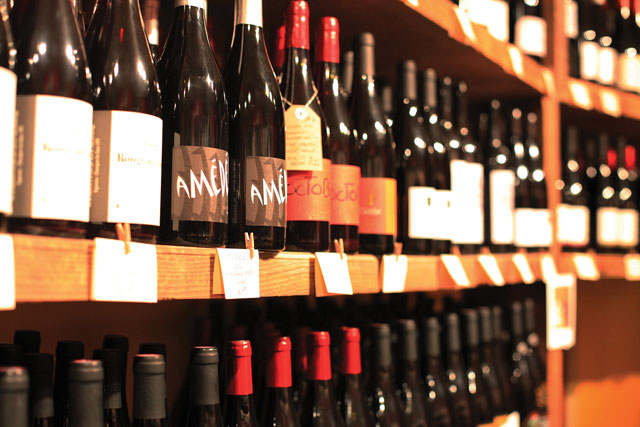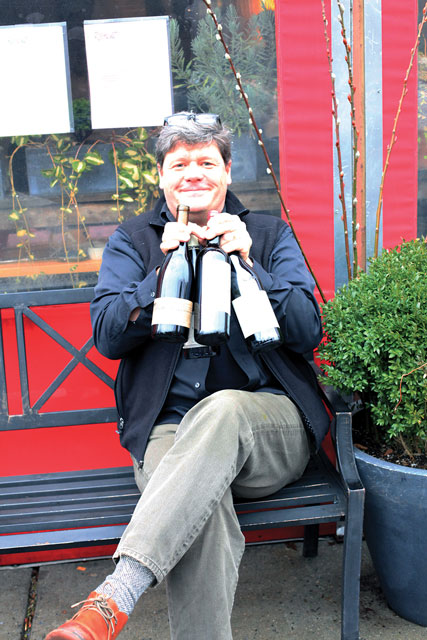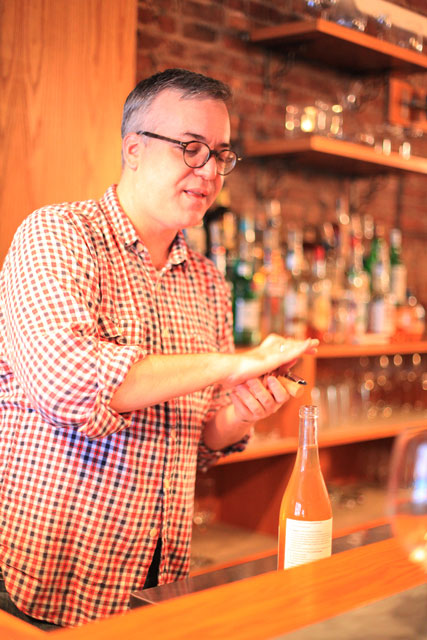The good, the earthy, and the funky: How natural wine is making a splash in Park Slope’s wine culture.
“So you know how when you get out of the shower, little drops of water cling to the hair on your arms? Well the hairs are trapping oxygen. That’s why the winemaker lined his vats in cow’s hide.” Phillipe Essome, or “Fifi” as he goes by, was explaining what, to me, was the very surprising process that went into the bottle of pais he had pulled off the shelf in his boutique on Vanderbilt Avenue, Passage de la Fleur.

Passage de la Fleur is one of the newer wine shops in the neighborhood, and it happens to exclusively sell natural wine. It’s part of a growing trend—not just in retail—but with many local restaurants. Peruse the wine lists of many local, notable establishments and you’ll probably notice footnotes demarcating things like biodynamic, organic, and sustainable. While these terms may appeal to locavores and socially-conscious gourmands, they are also indicators that you might find yourself with a glass of something unique and special. Anthony Mastropolo, General Manager of The Pines in Gowanus explains, “We actually are one of the only places in NYC that has a 100-percent natural wine list. We always have and plan on keeping it that way. I think our general opinion of natural wine is that it goes really well with food. Some of the super earthy, funky wines are a fantastic pair for our dry-aged duck breast or ribeye steaks.”
But what exactly is natural wine? Depends on who you ask. “Natural wine” isn’t a standardized term and it casts a wide net.
On one end of the spectrum, it can be like my bottle of pais purchased at Passage de la Fleur. The producer, Luis-Antoine Luyt, is a native Burgundian now living and making wine in the Maule Valley of Chile, and he’s one of the seminal figures heading up terroir-driven, minimal intervention winemaking methods in a region historically dominated by more industrial models. Luyt’s methods are as close as you’re likely to get to leaving the process to mother nature. The grapes are sourced either from local farmers or grown on rented, unirrigated vines on land worked only by horsepower. This particular wine was fermented in open-air tanks lined with a cow’s hide to introduce oxygen (which aids in the development of the yeasts and fosters the maturation of the wine.) Instead of introducing yeast into the juice, Luyt let mother nature take over—a process often referred to as spontaneous or wild fermentation. Whatever strain of native yeast was blowing around in the air of the Maule Valley was the strain that came in contact with the juice, did the dance of fermentation, and eventually resulted in what ended up in my glass.
These wines in particular are likely to deliver some surprising and off-the-wall tasting notes. They tend to have a funkiness to them—different animals altogether from the bigger, popular labels you may be used to. Yeasty, earthy, and barnyardy are going to be terms that come to mind when quaffing this stuff. You might even get a little hit of effervescence with that first glass—often a result of some secondary fermentation.
On the other hand, wines being produced just hours away from Park Slope in New York’s own wine regions such as the Finger Lakes and Long Island tend to be a little less unorthodox in their winemaking methods but are still making waves among natural wine lovers, nonetheless. For winemakers in these regions, there is a strong emphasis on preserving the local ecosystem and being kinder to the environment. The Long Island Sustainable Winegrowers (LISW) encourage local wineries to “make an attempt” at employing natural methods, such as using fewer herbicides and pesticides whenever possible: “[LISW] believe that vineyards should work in harmony with our natural world leaving the land we steward in better condition than when we found it, building a community between vineyards, workers, and the land.”
Natural wines from these regions maybe not be quite as esoteric or funky as those fermented in vats of cowhide, but these more hands-off methods have allowed grapes grown in New York’s own soil to express their own terroir. New World wines, particularly those from the east coast of the United States, have garnered a bad rap over the years as being overly manipulated, high-alcohol, “fruit bombs.” Lately though, New York wines especially are starting to move past that reputation, much in thanks to a more hands-off, Old World approach being employed in more and more local wineries.

By and large, natural winemaking is actually more about what you’re not doing to the wine. Pesticides are only the beginning when it comes to human intervention in the winemaking process. Every decision the vigneron makes will have an impact on how the grape ends up expressing itself in the glass. There are actually a couple hundred additives that can be introduced throughout the process—including anything from sugar, yeast, sulfites, and even colorants—which will end up manipulating the final product. When a winemaker begins to pull back, that’s when you really get a sense of terroir—that sense of place, time, climate, and soil that makes wine lovers wax poetic.
And really, that is maybe what makes natural wine so intriguing and special. John Tucker, owner of Rose Water in Park Slope, is a big champion of natural winemakers, and over the course of the past eight years has transitioned the restaurant’s wine list to feature natural wines almost exclusively. “I opened a natural, sustainable restaurant and [Rose Water’s wine list] is just an extension of that.” He goes on to note that the transparency of the winemaker’s methods makes these selections more preferable. Though there is a fashionable element to supporting the organic and sustainable agriculture movement, he also points out that this transparency translates into the glass. “It tastes like honest wine.”
And as Tucker points out, that is why there is such a growing interest by local somms, retailers, and consumers. “When push comes to shove, and you’re burying your nose deep in a glass of wine—at least for the connoisseurs—it doesn’t necessarily matter how these wines are produced. It matters how they are drank.” Matthew Stucky, General Manager of James in Prospect Heights, adds that these wines tend to make it onto their list because they’re just good. “We have quite a few sustainable wines on our list, but I’ll be honest with you, we never seek them out. More often than not we land on producers who are making wines that are organic, sustainable, or biodynamic. That being said, I am a fan of anything organic and sustainable and feel happy to be able to offer such great wines to our guests.”

The natural wine movement isn’t necessarily breaking new ground, though, as it is taking many steps back. Natural winemaking has been practiced for centuries in Old World regions long before the terms “organic” and “sustainable” were in vogue. While someone like Luyt may be seen as a renegade in highly industrialized New World regions like Chile, his methods draw upon knowledge and experience cultivated over many generations in his native Burgundy.
Brian Mitchell of Brookvin in South Slope observes, “I think what we’re seeing here is that people are trying to get back to how wines were made years ago.” Having recognized the growing appeal in natural wines, Mitchell has included a couple selections produced in this more traditional style, like the airén, a Spanish orange wine made from a varietal primarily used in brandy production.
It’s worth mentioning that natural isn’t always a guarantor of quality. There are many factors and processes that go into producing a great bottle of wine, and the very definition of what natural wine means is hotly debated among oenophiles. Furthermore, you’re not necessarily going to see natural wines obviously labeled as such. The real joy, though, in exploring this area of the wine world is in engaging with local sommeliers, shop owners, and restaurateurs. Not only can they help you identify what you’re looking for, but chances are they will enthusiastically share the unique stories behind each bottle on their shelves and wine lists. ◆
Here’s a list of where to begin your own exploration of natural wine:
| Big Nose, Full Body 382 7th Avenue bignosefullybody.comBrookvin 381 7th Avenue brookvin.comFermented Grapes 651 Vanderbilt Avenue fermentedgrapes.net |
James 605 Carlton Avenue jamesrestaurantny.comPassage de la Fleur 573 Vanderbilt Avenue passagedelafleur.comThe Pines 284 3rd Avenue thepinesbrooklyn.com |
Red, White, & Bubbly 211 5th Avenue mybrooklynwine.comRose Water 787 Union Street rosewaterrestaurant.comSip Fine Wine 67 5th Avenue sipfinewine.com |
Slope Cellars 436 7th Avenue slopecellars.com |
